Using a Ground Source Heat Pump System in China
Posted by Yuchen Zhang in Energy saving, HeatingTags: heat pump Add comments
 In March of 2009, I bought a house in my hometown – Jiaxing, which is in China. Jiaxing is located on the southeast coast line of China, 120 km from Shanghai. The house I bought has an interior area of 250 m2 with 3 floors and a basement. It also comes with a garden of 55 m2. With this house, I found an opportunity to try out a Ground Source Heat Pump system. For years I have been looking at the development of new trendy technologies. Now I am especially interested in new and renewable energies. By attempting to install such a Ground Source Heat Pump system in home, my intention is to use the ground heat for basic heating, cooling and providing all of the warm water needed for living in my home.
In March of 2009, I bought a house in my hometown – Jiaxing, which is in China. Jiaxing is located on the southeast coast line of China, 120 km from Shanghai. The house I bought has an interior area of 250 m2 with 3 floors and a basement. It also comes with a garden of 55 m2. With this house, I found an opportunity to try out a Ground Source Heat Pump system. For years I have been looking at the development of new trendy technologies. Now I am especially interested in new and renewable energies. By attempting to install such a Ground Source Heat Pump system in home, my intention is to use the ground heat for basic heating, cooling and providing all of the warm water needed for living in my home.
Written by Hanhua Zhang (translated and revised by Yuchen Zhang)
The Ground-coupled Tubes
The very first level of heat exchanging happens in the ground, with water circulating in the so-called ground-coupled tubes (http://en.wikipedia.org/wiki/Geothermal_heat_pump). In all there are 5 holes drilled in my garden, with each 96m deep and with a distance of 2.8 – 3.5m between. The vertically inserted tubes are interconnected by horizontally laid tubes, which is 1.5m underneath the ground surface.
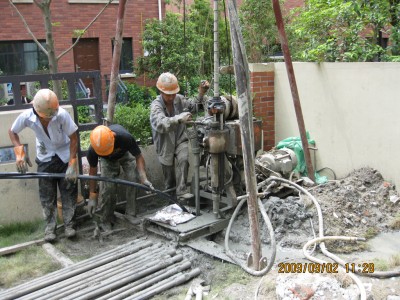
Drilling the hole in the ground and inserting the ground-coupled tube
As shown in the photo, the laying of the ground tubes is accomplished by a group of specialized workers
The Principle of the System
As shown in the figure below, the core of the whole system is the two heat exchangers. Each of the two is connected to both the ground tubes (source) and the indoor house pipes towards heating or cooling (load). Inside the machine there are yet two levels of heat exchanging. The source side has water circulating in the tubes to constantly absorb the heat from the earth, which is transferred to the internal refrigerant (Freon). After the internal heat is condensed, the heat is transferred to the load side through another level of exchange. In summer, the cooling of the house is achieved by ventilating air through the tubes with circulating cold water inside; in winter, the heating of the house is caused by the heat radiated from the subfloor circulating warm water. There are digital controllers, together with the solenoid valves, automatically adjusting the threshold temperature on a pre-set level.
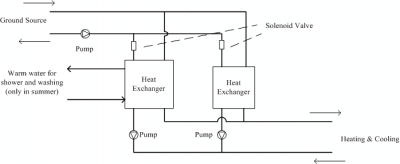
The System With Two Heat Exchangers
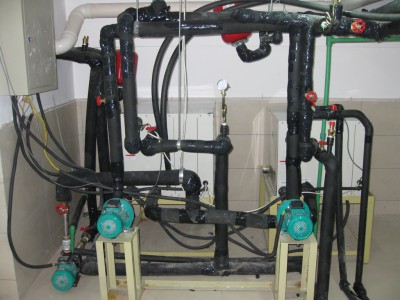
The Two Heat Exchangers in the Basement
In summer, the warm water in the house (for showers, washing, etc.) is heated by the recycled heat from the heat exchanger. Therefore, heating the warm water in summertime is basically free. In winter, the warm water is heated by the ground heat, using the same principle as subfloor heating. This still is 70% cheaper than using electricity. Together with a 200 liter tank, supplying 24-hour hot water in the whole house can be achieved.
The Subfloor Heating
See the following figure for a symbolic drawing about the subfloor heating system in the house. It is the so-called “Radiant Loops”. (http://en.wikipedia.org/wiki/Underfloor_heating#Modeling_piping_patterns_with_finite_element_analysis) that are buried under the floor to have warm water circulating inside. In my case, I used loops of 100 meters each for the radiation. As shown in the drawing, there are different amount of radiation loops deployed on different floors. The node between the main loop and radiation loops is called a “Radiant Manifold”, through which warm water flows into the radiation network and the colder water after circulation flows back to the main loop.
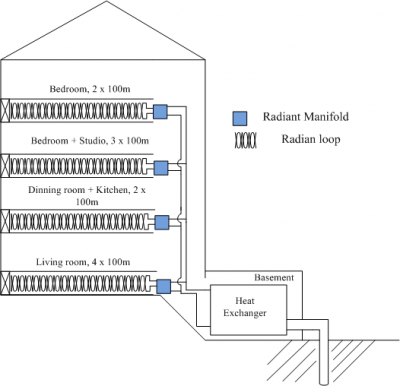
A Symbolic Drawing of the Main and Radiant Loops
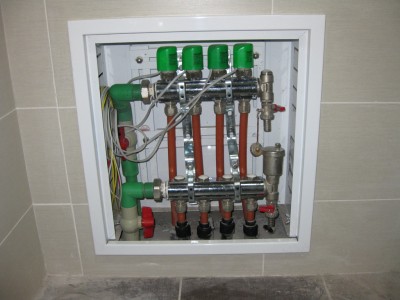
The Radiant Manifold in Living room (connected to 4 radiant loops x 100 meter)
Return on Investment
The investment in the complete system, including purchasing and installing the two heat exchangers, drilling the holes in the garden and laying out the U-tubes, deploying the subfloor heating and ventilators for cooling, is around 145k RMB. This, using a Foreign Exchange Rate rate of 9 : 1, equals to 16K euro ($22K). Compared to a conventional air-conditioning and heating system (using electricity), this initial investment is around 70K RMB more, or 7.8K euro ($10K). On the other hand, such a system only consumes 1/3 – 1/2 of the energy needed by a conventional air-conditioning or heating system. Assuming this system will be operating for 7-8 months of the year, a comparison with the conventional system for the same amount of time would mean a savings of 12K RMB per year on one’s energy bill. A rough estimation for the Return on Investment (ROI) is therefore is 6 years. Note that the electricity tariff in Jiaxing is on average 60 RMB cents per kWh, or 6.7 euro cents (8.7 dollar cents) per kWh .
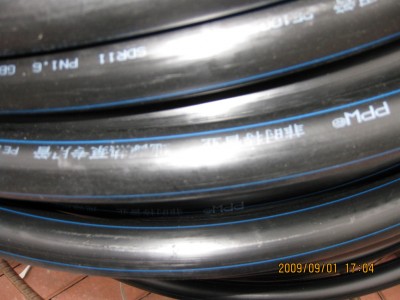
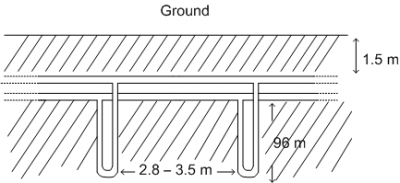



Most popular posts